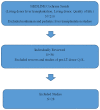A review of life quality in living donors after liver transplantation
- PMID: 25784970
- PMCID: PMC4358425
A review of life quality in living donors after liver transplantation
Abstract
Living-donor liver transplantation (LDLT) has increasingly performed all around the world. However, LDLT donors achieve no medical benefits and are exposed to the risk of complications, and even death. The potential effects of LDLT on donor safety, donor recovery, and post-donation psychological impairment are essential to be better understood. We searched the MEDLINE database to identify articles about the quality of life (QOL) in adults after LDLT donation. Twenty-eight studies with a total of 1944 donors were included in the review. 14 of the 28 studies (50%) had a cross-sectional design, and the remaining half had a prospective design. The Physical Component Score (PCS) decreased immediately after the donation, then returned to the baseline within 6 to 12 months while the Mental Component Score (MCS) remains comparable to that of normative population throughout the procedure. Compared with the left graft (LG) donors, right graft (RG) donors were significantly older, had longer hospital stays and higher rates of postoperative complications, and a higher recipient mortality rate, while there were no difference in the PCS and MCS between the two groups. Our review clearly indicates that the LDLT donors can endure the donation procedure and return to their normal daily life without major problem in the short term. However, to improve the donor selection criteria and ensure the QOL in donors throughout donation procedure, more studies with longer follow up and larger samples are essential and predictors of poor QOL should be identified in study with sufficient response rate and ideal control groups.
Keywords: Living donor; life quality; liver transplantation.
References
-
- Reichman TW, Katchman H, Tanaka T, Greig PD, McGilvray ID, Cattral MS, Renner EL, Selzner M, Ghanekar A, Levy G, Grant DR. Living donor versus deceased donor liver transplantation: a surgeon-matched comparison of recipient morbidity and outcomes. Transplant Int. 2013;26:780–787. - PubMed
-
- Hoehn RS, Wilson GC, Wima K, Hohmann SF, Midura EF, Woodle ES, Abbott DE, Singhal A, Shah SA. Comparing Living Donor and Deceased Donor Liver Transplant: A Matched National Analysis from 2007-2012. Liver Transpl. 2014;20:1347–55. - PubMed
-
- Wan P, Yu X, Xia Q. Operative outcomes of adult living donor liver transplantation and deceased donor liver transplantation: a systematic review and meta-analysis. Liver Transp. 2014;20:425–436. - PubMed
-
- Ozgor D, Dirican A, Ates M, Gonultas F, Ara C, Yilmaz S. Donor complications among 500 living donor liver transplantations at a single center. Transplant Proc. 2012;44:1604–1607. - PubMed
-
- Cheah YL, Simpson MA, Pomposelli JJ, Pomfret EA. Incidence of death and potentially life-threatening near-miss events in living donor hepatic lobectomy: a world-wide survey. Liver Transpl. 2013;19:499–506. - PubMed
Publication types
LinkOut - more resources
Full Text Sources

